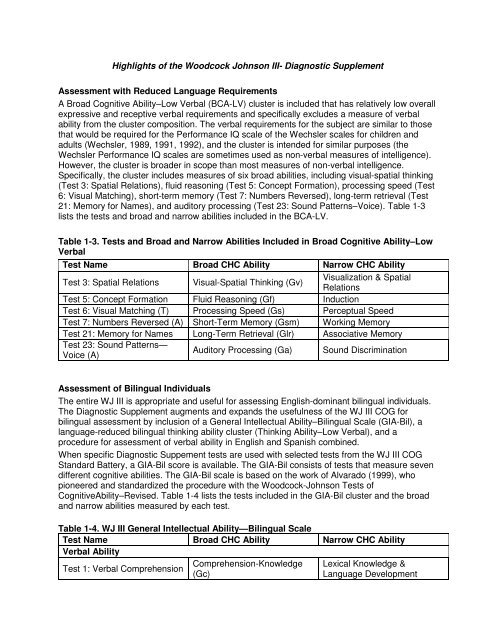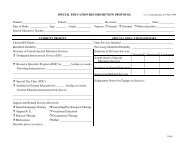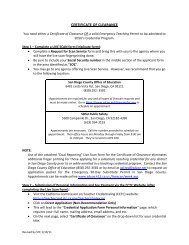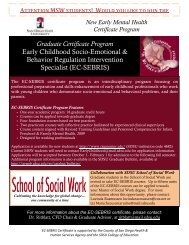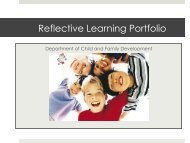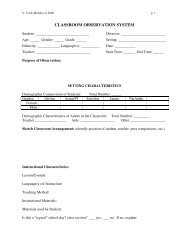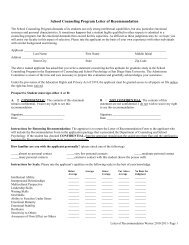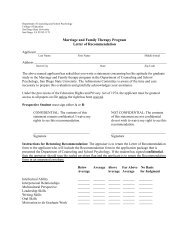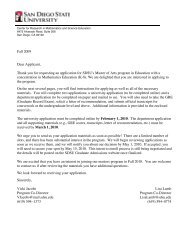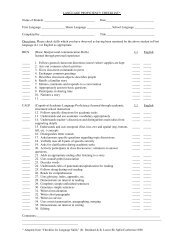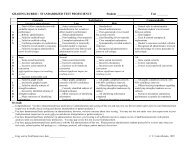Highlights of the Woodcock Johnson III- Diagnostic Supplement ...
Highlights of the Woodcock Johnson III- Diagnostic Supplement ...
Highlights of the Woodcock Johnson III- Diagnostic Supplement ...
You also want an ePaper? Increase the reach of your titles
YUMPU automatically turns print PDFs into web optimized ePapers that Google loves.
<strong>Highlights</strong> <strong>of</strong> <strong>the</strong> <strong>Woodcock</strong> <strong>Johnson</strong> <strong>III</strong>- <strong>Diagnostic</strong> <strong>Supplement</strong>Assessment with Reduced Language RequirementsA Broad Cognitive Ability–Low Verbal (BCA-LV) cluster is included that has relatively low overallexpressive and receptive verbal requirements and specifically excludes a measure <strong>of</strong> verbalability from <strong>the</strong> cluster composition. The verbal requirements for <strong>the</strong> subject are similar to thosethat would be required for <strong>the</strong> Performance IQ scale <strong>of</strong> <strong>the</strong> Wechsler scales for children andadults (Wechsler, 1989, 1991, 1992), and <strong>the</strong> cluster is intended for similar purposes (<strong>the</strong>Wechsler Performance IQ scales are sometimes used as non-verbal measures <strong>of</strong> intelligence).However, <strong>the</strong> cluster is broader in scope than most measures <strong>of</strong> non-verbal intelligence.Specifically, <strong>the</strong> cluster includes measures <strong>of</strong> six broad abilities, including visual-spatial thinking(Test 3: Spatial Relations), fluid reasoning (Test 5: Concept Formation), processing speed (Test6: Visual Matching), short-term memory (Test 7: Numbers Reversed), long-term retrieval (Test21: Memory for Names), and auditory processing (Test 23: Sound Patterns–Voice). Table 1-3lists <strong>the</strong> tests and broad and narrow abilities included in <strong>the</strong> BCA-LV.Table 1-3. Tests and Broad and Narrow Abilities Included in Broad Cognitive Ability–LowVerbalTest Name Broad CHC Ability Narrow CHC AbilityTest 3: Spatial Relations Visual-Spatial Thinking (Gv)Visualization & SpatialRelationsTest 5: Concept Formation Fluid Reasoning (Gf) InductionTest 6: Visual Matching (T) Processing Speed (Gs) Perceptual SpeedTest 7: Numbers Reversed (A) Short-Term Memory (Gsm) Working MemoryTest 21: Memory for Names Long-Term Retrieval (Glr) Associative MemoryTest 23: Sound Patterns—Voice (A)Auditory Processing (Ga) Sound DiscriminationAssessment <strong>of</strong> Bilingual IndividualsThe entire WJ <strong>III</strong> is appropriate and useful for assessing English-dominant bilingual individuals.The <strong>Diagnostic</strong> <strong>Supplement</strong> augments and expands <strong>the</strong> usefulness <strong>of</strong> <strong>the</strong> WJ <strong>III</strong> COG forbilingual assessment by inclusion <strong>of</strong> a General Intellectual Ability–Bilingual Scale (GIA-Bil), alanguage-reduced bilingual thinking ability cluster (Thinking Ability–Low Verbal), and aprocedure for assessment <strong>of</strong> verbal ability in English and Spanish combined.When specific <strong>Diagnostic</strong> Suppement tests are used with selected tests from <strong>the</strong> WJ <strong>III</strong> COGStandard Battery, a GIA-Bil score is available. The GIA-Bil consists <strong>of</strong> tests that measure sevendifferent cognitive abilities. The GIA-Bil scale is based on <strong>the</strong> work <strong>of</strong> Alvarado (1999), whopioneered and standardized <strong>the</strong> procedure with <strong>the</strong> <strong>Woodcock</strong>-<strong>Johnson</strong> Tests <strong>of</strong>CognitiveAbility–Revised. Table 1-4 lists <strong>the</strong> tests included in <strong>the</strong> GIA-Bil cluster and <strong>the</strong> broadand narrow abilities measured by each test.Table 1-4. WJ <strong>III</strong> General Intellectual Ability—Bilingual ScaleTest Name Broad CHC Ability Narrow CHC AbilityVerbal AbilityTest 1: Verbal ComprehensionComprehension-Knowledge(Gc)Lexical Knowledge &Language Development
Test 31 Bilingual VerbalComprehensionThinking AbilitiesComprehension-Knowledge(Gc)Lexical Knowledge &Language DevelopmentTest 3: Spatial Relations Visual-Spatial Thinking (Gv)Visualization & SpatialRelationsTest 5: Concept Formation Fluid Reasoning (Gf) InductionTest 21: Memory for Names Long-Term Retrieval (Glr) Associative MemoryTest 23: Sound Patterns—Voice (A)Auditory Processing (Ga) Sound DiscriminationCognitive EfficiencyTest 6: Visual Matching (T) Processing Speed (Gs) Perceptual SpeedTest 7: Numbers Reversed (A) Short-Term Memory (Gsm) Working MemoryThe GIA-Bil scale includes six tests that utilize a language-reduced test format. Additionally, forEnglish-Spanish bilingual subjects, <strong>the</strong> GIA-Bil measures four aspects <strong>of</strong> verbal ability using abilingual assessment procedure. This combination <strong>of</strong> language-reduced tests and bilingualtesting <strong>of</strong> verbal ability allows <strong>the</strong> examiner <strong>the</strong> opportunity to explore relative strengths andweaknesses among <strong>the</strong> verbal ability, thinking ability, and cognitive efficiency capabilities <strong>of</strong>bilingual individuals.Verbal Ability. Test 1: Verbal Comprehension includes four subtests that measure verbalability, or <strong>the</strong> CHC broad ability <strong>of</strong> comprehension-knowledge (Gc). The test is administered inEnglish. Items answered incorrectly on Test 1 can be subsequently administered in Spanishusing Test 31: Bilingual Verbal Comprehension. This procedure provides a measure <strong>of</strong> verbalcomprehension in English and Spanish combined. This score is used in calculation <strong>of</strong> <strong>the</strong> GIA-Bil score.Alternatively, examiners can utilize <strong>the</strong> Bilingual Verbal Ability Tess (BVAT) to obtain a measure<strong>of</strong> bilingual verbal comprehension in several o<strong>the</strong>r languages for English-dominant bilingualindividuals. The BVAT includes a more expansive set <strong>of</strong> verbal ability tests in English, withtranslations in Arabic, Chinese (Traditional and Simplified), French, German, Haitian-Creole,Hindi, Hmong, Italian, Japanese, Korean, Navajo, Polish, Portuguese, Russian, Spanish,Turkish, and Vietnamese. When included, <strong>the</strong> BVAT score serves as <strong>the</strong> measure <strong>of</strong> verbalcomprehension in <strong>the</strong> GIA-Bil scale.Thinking Ability. The four thinking ability tests included in <strong>the</strong> GIA-Bil scale were selected forinclusion because (a) <strong>the</strong> language requirements for each test are relatively low when comparedto o<strong>the</strong>r alternatives for assessing <strong>the</strong> same broad CHC ability and (b) each test wasappropriate for use with young children. That is, <strong>the</strong> language used in <strong>the</strong> test directions is at asufficiently low level <strong>of</strong> abstraction that young, English-dominant bilingual individuals can beassessed. In some cases, <strong>the</strong> test’s sample items, controlled feedback, and query proceduresassist <strong>the</strong> examiner in ascertaining <strong>the</strong> subject’s understanding. The following descriptionsdemonstrate <strong>the</strong> appropriateness <strong>of</strong> <strong>the</strong>se tests as measures <strong>of</strong> thinking abilities for bilingualindividuals.
In Test 3: Spatial Relations, all subjects begin with an introduction and sample items thatinclude a standardized procedure to ensure <strong>the</strong> subject understands <strong>the</strong> directions. Additionally,a pointing response may be used if <strong>the</strong> subject does not know <strong>the</strong> letter names. Test 3: SpatialRelations is a measure <strong>of</strong> visual-spatial thinking (Gv).Test 21: Memory for Names measures long-term retrieval (Glr) in a controlled-learning formatthat assures all subjects are given identical opportunities to learn <strong>the</strong> task. Prior learning doesnot affect test performance. Additionally, <strong>the</strong> test utilizes a pointing response from <strong>the</strong> subject so<strong>the</strong>re are no expressive language requirements. Incorrect responses are identified immediately.That is, <strong>the</strong> examiner acknowledges <strong>the</strong> incorrect response and <strong>the</strong>n points to <strong>the</strong> correctresponse; this procedure helps clarify understanding <strong>of</strong> <strong>the</strong> task requirement.Test 23: Sound Patterns–Voice is a measure <strong>of</strong> auditory processing (Ga). The test isappropriate for assessing <strong>the</strong> sound discrimination abilities <strong>of</strong> bilingual individuals because <strong>the</strong>reare no meaningful language components in <strong>the</strong> test stimuli. For this test, <strong>the</strong> subject needs onlyto understand <strong>the</strong> concepts <strong>of</strong> “same” and “different.”Test 5: Concept Formation is a test <strong>of</strong> fluid reasoning (Gf). Although this test requires somebasic English-language vocabulary knowledge (such as <strong>the</strong> words different, drawing, and rule),ei<strong>the</strong>r beforehand or gained through <strong>the</strong> teaching/modeling characteristic <strong>of</strong> <strong>the</strong> test directions,bilingual subjects with English oral-language abilities at <strong>the</strong> age 4-0 level or higher typically have<strong>the</strong> English-language vocabulary required for this test. Through standardized introduction andsample items that utilize corrective feedback, all subjects are given <strong>the</strong> opportunity to learn <strong>the</strong>task demands.These four thinking ability tests also comprise <strong>the</strong> Thinking Ability–Low Verbal cluster. Thiscluster provides a language-reduced composite <strong>of</strong> a subject’s intentional cognitive processingcapabilities.Cognitive Efficiency. Two tests comprise <strong>the</strong> Cognitive Efficiency–Standard cluster, whichmeasures <strong>the</strong> subject’s rate and span <strong>of</strong> automatic cognitive processing. Test 6: VisualMatching is a measure <strong>of</strong> processing speed (Gs) and Test 7: Numbers Reversed is a measure<strong>of</strong> short-term memory (Gsm). Both <strong>of</strong> <strong>the</strong>se tests have low receptive language requirements.Two versions <strong>of</strong> Test 6: Visual Matching are available. Test 6: Visual Matching 1 requires <strong>the</strong>subject to point to two matching shapes in a row <strong>of</strong> four to five shapes. Test 6: Visual Matching2 requires <strong>the</strong> subject to locate and circle <strong>the</strong> two identical numbers in a row <strong>of</strong> six numbers.There are no expressive language requirements for Test 6: Visual Matching.Test 7: Numbers Reversed requires some basic English-language vocabulary knowledge (suchas <strong>the</strong> words numbers and backward and <strong>the</strong> numeral names “one” through “nine”). However,bilingual subjects with English oral language abilities at <strong>the</strong> age 5-0 level or higher typically have<strong>the</strong> English-language vocabulary required for this test.Examiners who administer <strong>the</strong> tests included in <strong>the</strong> GIA-Bil scale can obtain additionaldiagnostic information from <strong>the</strong> intra-cognitive–standard discrepancy procedure. When ei<strong>the</strong>rTest 31: Bilingual Verbal Comprehension–English/Spanish or <strong>the</strong> BVAT has been administered,<strong>the</strong> verbal ability includes responses to items administered in <strong>the</strong> subject’s first language. Also,<strong>the</strong> Thinking Ability–Low Verbal score is evaluated against <strong>the</strong> same “O<strong>the</strong>r” score as ThinkingAbility–Standard.
Assessment <strong>of</strong> Young ChildrenThe <strong>Diagnostic</strong> <strong>Supplement</strong> contains selected tests that are particularly useful for assessment<strong>of</strong> young children or for individuals <strong>of</strong> any age who function at a preschool level. The testsinclude engaging tasks and colorful pictures that interest young children. As a practicalconsideration, <strong>the</strong> tests are time efficient, taking approximately 5 to 10 minutes per test toadminister. This saves time and effort that normally would be expended on lengthy instruments.Additionally, natural breaks between tests allow examiners <strong>the</strong> option <strong>of</strong> dividing testing into twoor more sessions. This can be helpful when <strong>the</strong> child’s attention or response style is not optimal.When used with selected tests from <strong>the</strong> WJ <strong>III</strong> COG Standard Battery, a General IntellectualAbility–Early Development Scale (GIA-EDev) is available consisting <strong>of</strong> tests that measure sixdifferent cognitive abilities. (The GIA-EDev cluster does not include a measure <strong>of</strong> fluid reasoning[Gf].) Table 1-6 lists <strong>the</strong> tests included in <strong>the</strong> GIA-EDev cluster and <strong>the</strong> broad and narrowabilities measured by each test.Table 1-6. WJ <strong>III</strong> General Intellectual Ability—Early Development ScaleTest Name Broad CHC Ability Narrow CHC AbilityVerbal AbilityTest 1: Verbal ComprehensionComprehension-Knowledge Lexical Knowledge & Language(Gc)DevelopmentTest 31: Bilingual VerbalComprehensionComprehension-Knowledge(Gc)Lexical Knowledge & LanguageDevelopmentThinking AbilitiesTest 8: Incomplete Words (A) Auditory Processing (Ga) Phonetic Coding: AnalysisTest 21: Memory for Names Long-Term Retrieval (Glr) Associative MemoryTest 22: Visual Closure Visual-Spatial Thinking (Gv) Closure SpeedCognitive EfficiencyTest 6: Visual Matching (T) Processing Speed (Gs) Perceptual SpeedTest 27: Memory forSentences (A)Short-Term Memory (Gsm) Auditory Memory Span


